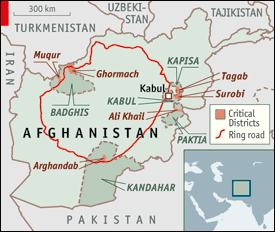Hopes are high that a new Afghanistan strategy and 30,000 extra U.S. troops will prove to be a turning point in the fight against Al Qaeda and the Taliban, much as similar measures changed the nature of the counterinsurgency in Iraq.
The moves are in line with Obama’s goal of refocusing anti-terror efforts toward Afghanistan. Presently, there are about 62,000 international troops in the country, with about 32,000 from the U.S.
Already, 3,000 troops are scheduled to arrive in Afghanistan in January, and Defense Secretary Gates recently approved the deployment of a 2,800-strong combat brigade by the spring. Around 20,000 to 30,000 additional U.S. troops will arrive in Afghanistan over the next 12 to 18 months. Furthermore, in March, the UK will begin diverting its forces from Iraq to Afghanistan. The British government has also stated it is willing to send an additional 2,000 troops to the country. According to the NYT, military commanders want to significantly increase the size of the Afghan Army as well, from 70,000 to 134,000 in the next five years or so.
Now, after months of planning, the new strategy is due to be unveiled in the next several weeks by the UN and the Afghan government. The Economist:
According to officers in the NATO-led force, the first priority will be to reclaim the ring-road, Afghanistan’s main artery, around which the main population centers are concentrated. This route was rebuilt with Western aid after the toppling of the Taliban, but has become increasingly dangerous. The sections south of the capital, Kabul, are largely cut off by Taliban insurgents and criminal gangs.
Afghanistan’s Ring Road (Economist) With more Western troops, and the training of a greater number of Afghan security forces, another aim will be to strengthen areas where the government is in danger of losing control. Forty such districts will be the target of a comprehensive military and political effort to stop them from falling into Taliban hands. A pilot scheme involving the first five of these so-called “critical districts” is due to be set up soon.
Tribal powerbrokers in these areas will be invited to agree to a “contract.” The government, backed by international forces, will undertake to provide security, bring economic development and give each tribal council or shura (whose members will be paid by the government) a greater say in the running of local affairs. In return, the tribes will promise to expel and deter insurgents, and to provide recruits (probably about 50 per district) for a local force that would perform guard duties.
As violence in Afghanistan spikes, a change in strategy is desperately needed, especially one that works with civilians and takes into account existing social networks. The Economist on the major obstacles facing such a rethink:
Afghan and Western officials working in the provinces agree that, if the new approach is to work, the right choice of shura members will be crucial. But maintaining these bodies will not be cheap for the Kabul government; the proposed wage for members has already been cut from $200 to $120 a month.
Balancing local factions is notoriously difficult. “The government is weak and people are losing faith,” says Haji Bidar Zazai, an MP from Ali Khail, a proposed “critical district” in Paktia. “We have eight tribes in our district but if a shura is not representative of all eight it will never work.”
Relying on tribal structures may work best in the south-east of the country, where the tribes are comparatively stable and cohesive. In the south, however, tribal structures are weaker, warlords tend to dominate and insurgents exploit tribal rivalries. In Iraq, the Sunni tribes were vital to success; in Afghanistan, tribal rivalries may undo the best-laid plans.
There are reasons to be skeptical. As my colleague James Joyner noted in a piece from October, many analysts do not see Afghanistan as analogous to Iraq, given the entrenched Afghan tribal structures, ethnic fractionalization, and its near constant state of war for the last three decades. Moreover, the fragile security situation in Pakistan’s tribal areas is inextricable from the situation in southern Afghanistan. Aside from the UK, major NATO troop contributions are also doubtful.
However, the Iraq surge should at least have taught us that condemning a strategy before it is underway can be unduly pessimistic.
Peter Cassata is an assistant editor at the Atlantic Council.


